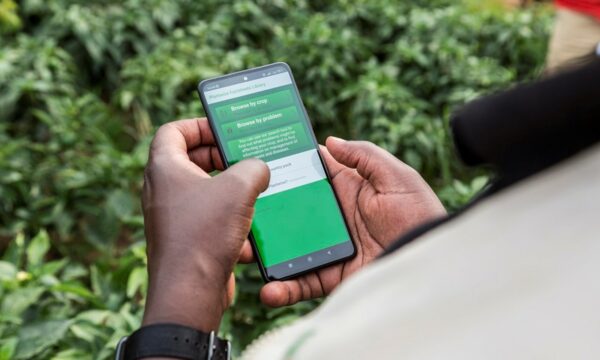Jatropha curcas, image courtesy of Biofuels Information Exchange
It has come to my attention that Jatropha curcas (physic nut or purging nut) is being pushed in India as a biofuel crop (for oil) and that there is now an emerging public health problem there due to accidental poisoning of children.
An Indian member of the listserv HIFA2015 to which I belong, Pankaj Oudhia, reported increased hospitalisations of children across the nation during the Jatropha fruiting season in 2010. The seeds are tasty but it only takes 3 or 4 seeds and you end up in hospital. Five children died. Cultivated in fields as the biofuel crop, he also reported it was deliberately planted in schools.
Here at CABI, our scientists, projects and information specialists have much to offer on the topic of biofuels and in 2008 we launched the Biofuels Information Exchange. So I went straight there to see if they had discussed Jatropha in their Forum, which they had (see “Is jatropha really the 'miracle' biofuel crop that some profess it to be?” from Carole Ellison).
AS a biofuel crop its in its infancy and has many downsides, not least on food security & the fact that you can’t use the husks for feed. One of the reasons it was even considered was that as a weed (originating in South America) it was thought likely to be easy & cheap to cultivate. Turns out to make it productive you do have to go heavy on the fertiliser (expensive) and it also can harbour a mosaic virus. Only in passing was it pointed out that the seeds were poisonous and then only with reference to its use for animal feed.
One of the issues raised in this HIFA2015 communication was the lack of knowledge in the local communities about the poisonous nature of the seeds, so that parents could not forewarn their children. And obviously the authorities had no idea otherwise they’d not have planted them in schools!
Definitely a lack of communication between botanists, agriculturalists, governments and medics when it comes to people’s health.
Let’s not get complacent here in Europe. WE all need reminding which plants are poisonous or irritating in gardens and in the hedgerows. Then we should tell children not to eat or touch them. Just because a bird is eating a juicy red berry does not make it edible for humans or even your pet dog.
Knowing a traditional name helps even us….deadly nightshade is a dead give-away isn’t it?
Another worrying aspect was that children who recover from Jatropha poisoning seem to have their subsequent school career affected, being “backbenched” by its effect on their nervous system just as “Lead (Pb)” can do… which is why unleaded fuel was introduced as a public health measure in Europe. Research is required to investigate if this effect can be substantiated, for Pankaj claims there is no specific mention of it in modern literature.
I was of course aware of the controversy over biofuels because of their negative effects on food security, when poor countries devote increased acreage to grow a non- food biofuel crop rather than grow food or indeed grow a food crop for fuel rather than eat it. Other CABI bloggers have discussed this previously and nutrition is a public health issue.See One for the road.. and Nourishing the planet: Agricultural innovations to feed the world.
I’d also thought about increased aeroallergens as weeds become biofuel “crops”.
But this is a new one on me.
Having taken advice from the Forum, another potential biofuel crop which is poisonous (but not as bad as Jatropha c.) is Pongamia pinnata . Like Jatropha curcas, this plant is considered a medicinal plant with much research on it for these properties, especially as an insecticide.
I have had a look at our Global Health database for these two plants and found both examples of poisoning AND awareness in the modern research literature there. From places as far away as China and Brazil…
Statistics:
- Records in Global Health on poisoning & allergies in children caused by weeds & noxious plants: 338 records achieved simply by searching for (FF500 and children)
- Records on Global Health on Jatropha curcas: 184 (as a herbal medicine).
Add poison* to the search string and you pull out 49/184 highlighting how poisonous it is! One record details its use after detoxification as a fishfeed & a 1927 record recommends stomach pumping, so therapy has changed little. - Records on Pongamia pinnata: 201 (mostly as an insecticide). Mentioned as a “fish poison” & insecticide as far back as 1932.
Records:
As a subscriber to Global Health or a member of our Global Health Knowledge Base you could access the following records.. You can see from the titles why I picked them!
- Jatropha: a herbal medicine for biodiesel. Silva Júnior, A. A.; Agropecuária Catarinense, 2010, 23, 2, pp 35-37
- Management for rescue of 23 collective poisoning children due to Jatropha. (China).Ye Feng; Chi WenYuan; China Tropical Medicine, 2009, 9, 12, pp 2326-2327
- Jatropha poisoning in children. (India) .Singh, R. K.; Singh, D.; Mahendrakar, A. G., Medical Journal Armed Forces India, 2010, 66, 1, pp 80-81
- Procedures in the handling of toxic, allergenic and antinutritional components of jatropha and its products (Brazil). Gonçalves, S. B.; Mendonça, S.; Laviola, B. G., Circular Técnica – Embrapa Agroenergia, 2009, 01, pp 5
- Landscaping and biofuel potentials of bani (pongamia pinnata). (Philippines).Gonzales, L. L.; Sinohin, V. O.; Calinawan, R.; Canopy International, 2008, 34, 1/6, pp 2
Related News & Blogs
CABI conducts workshop in India to help pave the way for better FAIR data processes in agriculture
CABI, as part of the Enabling FAIR data sharing and responsible data use project, has conducted a workshop in Delhi, India, to help pave the way for better FAIR data processes in agriculture. The project, funded by the Bill & Melinda Gates Foundati…
8 January 2024





